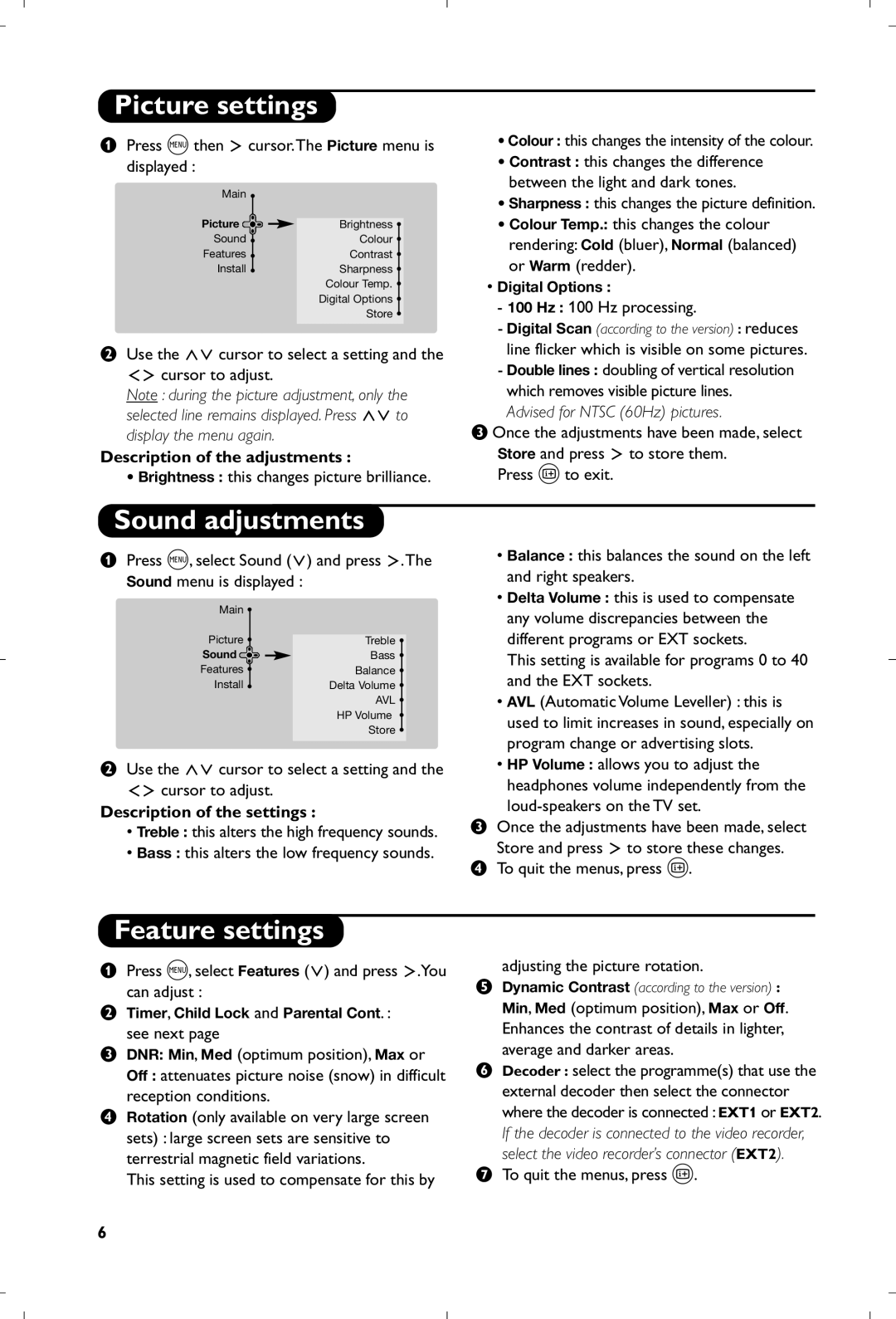
Picture settings
&Press H then ≥ cursor.The Picture menu is displayed :
Main • |
| |||
Picture |
|
|
| |
Brightness • | ||||
|
| |||
Sound • | Colour • | |||
Features • | Contrast • | |||
Install • | Sharpness • | |||
|
|
| Colour Temp. • | |
|
|
| Digital Options • | |
|
|
| Store • | |
|
|
|
| |
éUse the <> cursor to select a setting and the ≤≥ cursor to adjust.
Note : during the picture adjustment, only the selected line remains displayed. Press <> to display the menu again.
Description of the adjustments :
•Brightness : this changes picture brilliance.
•Colour : this changes the intensity of the colour.
•Contrast : this changes the difference between the light and dark tones.
•Sharpness : this changes the picture definition.
•Colour Temp.: this changes the colour
rendering: Cold (bluer), Normal (balanced) or Warm (redder).
•Digital Options :
-100 Hz : 100 Hz processing.
-Digital Scan (according to the version) : reduces line flicker which is visible on some pictures.
-Double lines : doubling of vertical resolution which removes visible picture lines.
Advised for NTSC (60Hz) pictures.
“Once the adjustments have been made, select
Store and press ≥ to store them. Press d to exit.
Sound adjustments
&Press H, select Sound (>) and press ≥.The Sound menu is displayed :
Main • |
| ||
Picture • |
| ||
Treble • | |||
Sound |
|
| Bass • |
| |||
Features • | Balance • | ||
Install • | Delta Volume • | ||
|
|
| AVL • |
|
|
| HP Volume • |
|
|
| Store • |
|
|
|
|
éUse the <> cursor to select a setting and the ≤≥ cursor to adjust.
Description of the settings :
•Treble : this alters the high frequency sounds.
•Bass : this alters the low frequency sounds.
•Balance : this balances the sound on the left and right speakers.
•Delta Volume : this is used to compensate any volume discrepancies between the different programs or EXT sockets.
This setting is available for programs 0 to 40 and the EXT sockets.
•AVL (Automatic Volume Leveller) : this is used to limit increases in sound, especially on program change or advertising slots.
•HP Volume : allows you to adjust the headphones volume independently from the
“Once the adjustments have been made, select Store and press ≥ to store these changes.
‘ To quit the menus, press d.
Feature settings
&Press H, select Features (>) and press ≥.You can adjust :
éTimer, Child Lock and Parental Cont. : see next page
“DNR: Min, Med (optimum position), Max or
Off : attenuates picture noise (snow) in difficult reception conditions.
‘Rotation (only available on very large screen sets) : large screen sets are sensitive to terrestrial magnetic field variations.
This setting is used to compensate for this by
adjusting the picture rotation.
(Dynamic Contrast (according to the version) :
Min, Med (optimum position), Max or Off. Enhances the contrast of details in lighter, average and darker areas.
§Decoder : select the programme(s) that use the external decoder then select the connector where the decoder is connected : EXT1 or EXT2. If the decoder is connected to the video recorder, select the video recorder’s connector (EXT2).
è To quit the menus, press d.
6
